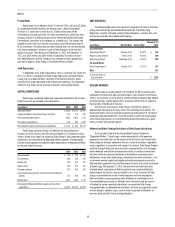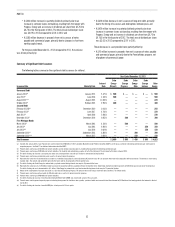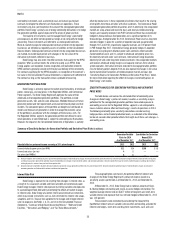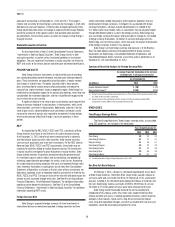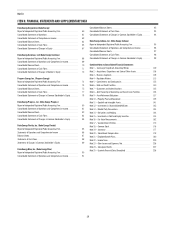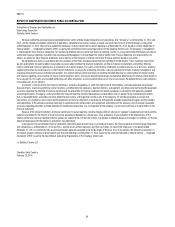Duke Energy 2013 Annual Report Download - page 68
Download and view the complete annual report
Please find page 68 of the 2013 Duke Energy annual report below. You can navigate through the pages in the report by either clicking on the pages listed below, or by using the keyword search tool below to find specific information within the annual report.
50
PART II
CASH FLOWS FROM OPERATING ACTIVITIES
The relatively stable operating cash flows of Regulated Utilities compose
a substantial portion of Duke Energy’s cash flows from operations. Regulated
Utilities’ cash flows from operations are primarily driven by sales of electricity
and natural gas and costs of operations. Weather conditions, commodity price
fluctuations and unanticipated expenses, including unplanned plant outages
and storms can affect the timing and level of cash flows from operations. Duke
Energy provides the liquidity support for Commercial Power’s coal-fired and
gas-fired assets that are dispatched into the PJM wholesale market. Commercial
Power has economically hedged a portion of its forecasted generation through
2018 with various counterparties, and a substantial portion of these contracts
require daily posting of margin, which can be significant. Duke Energy believes
it has sufficient liquidity resources through the commercial paper markets, and
ultimately, the master credit facility, to support these operations. Cash flows
from operations are subject to a number of other factors, including, but not
limited to, regulatory constraints, economic trends and market volatility (see
Item 1A, “Risk Factors,” for additional information).
At December 31, 2013, Duke Energy had cash and cash equivalents and
short-term investments of $1.5 billion, of which $1.1 billion is held by entities
domiciled in foreign jurisdictions and is forecasted to be used to fund the
operations of and investments in International Energy. Undistributed foreign
earnings associated with International Energy’s operations are considered
indefinitely reinvested. As a result, no U.S. tax is recorded on such earnings.
This assertion is based on management’s determination that the cash held in
International Energy’s foreign jurisdictions is not needed to fund the operations
of its U.S. operations and that International Energy either has invested or has
intentions to reinvest such earnings. While management currently intends to
indefinitely reinvest all of International Energy’s unremitted earnings, should
circumstances change, Duke Energy may need to record additional income tax
expense in the period in which such determination changes. The cumulative
undistributed earnings as of December 31, 2013, on which Duke Energy has
not provided deferred U.S. income taxes and foreign withholding taxes is
approximately $2.4 billion. The amount of unrecognized deferred tax liability
related to these undistributed earnings is estimated at between $300 million and
$375 million. See Note 22 to the Consolidated Financial Statements, “Income
Taxes,” for additional information.
DEBT ISSUANCES
Depending on availability based on the issuing entity, the credit rating of
the issuing entity, and market conditions, the Subsidiary Registrants prefer to
issue first mortgage bonds and secured debt, followed by unsecured debt. This
preference is the result of generally higher credit ratings for first mortgage bonds
and secured debt, which typically result in lower interest costs. Duke Energy
Corporation primarily issues unsecured debt.
Duke Energy’s capitalization is balanced between debt and equity as
shown in the table below. The 2014 projected capitalization percentages exclude
purchase accounting adjustments related to the merger with Progress Energy.
Projected
2014 Actual 2013 Actual 2012
Equity 52 %50 % 50 %
Debt 48 % 50 % 50 %
Duke Energy’s fixed charges coverage ratio, calculated using SEC
guidelines, was 3.0 times for 2013, 2.5 times for 2012, and 3.2 times for 2011.
Restrictive Debt Covenants
Duke Energy’s debt and credit agreements contain various financial and
other covenants. The master credit facility contains a covenant requiring the
debt-to-total capitalization ratio to not exceed 65 percent for each borrower.
Failure to meet those covenants beyond applicable grace periods could result in
accelerated due dates and/or termination of the agreements or sublimits thereto.
As of December 31, 2013, Duke Energy was in compliance with all covenants
related to its significant debt agreements. In addition, some credit agreements
may allow for acceleration of payments or termination of the agreements due
to nonpayment, or to the acceleration of other significant indebtedness of the
borrower or some of its subsidiaries. None of the debt or credit agreements
contain material adverse change clauses.
Credit Ratings
Duke Energy and certain subsidiaries each hold credit ratings by Fitch
Ratings, Inc. (Fitch), Moody’s Investors Service, Inc. (Moody’s) and Standard &
Poor’s Rating Services (S&P). Duke Energy’s corporate credit rating and issuer
credit rating from Fitch, Moody’s and S&P, respectively, as of February 13, 2013
is BBB+, A3 and BBB+, respectively. As of February 13, 2014, the Duke Energy
Registrants’ have stable outlooks from Fitch, Moody’s and S&P.
The following table includes the Duke Energy and certain subsidiaries’
Senior Unsecured Credit Ratings as of February 13, 2014.
S&P Moody’s Fitch
Duke Energy Corporation BBB A3 BBB+
Duke Energy Carolinas BBB+ A1 A
Progress Energy BBB Baa1 BBB
Duke Energy Progress BBB+ A1 A
Duke Energy Florida BBB+ A3 A-
Duke Energy Ohio BBB+ Baa1 A-
Duke Energy Indiana BBB+ A2 A-
Duke Energy Kentucky BBB+ Baa1 A-
Credit ratings are dependent on the ability to meet our debt principal and
interest obligations when they come due, which is a measure of the strength
of the current balance sheet. If, as a result of market conditions or other
factors, Duke Energy and certain other subsidiaries are unable to maintain
current balance sheet strength, or if earnings and cash flow outlook materially
deteriorates, credit ratings could be negatively impacted.
Cash Flow Information
The following table summarizes Duke Energy’s cash flows for the three
most recently completed fiscal years.
(in millions)
Years Ended December 31,
2013 2012 2011
Cash flows provided by (used in):
Operating activities $ 6,382 $ 5,244 $ 3,672
Investing activities (4,978) (6,197) (4,434)
Financing activities (1,327) 267 1,202
Net increase (decrease) in cash and cash
equivalents 77 (686) 440
Cash and cash equivalents at beginning of period 1,424 2,110 1,670
Cash and cash equivalents at end of period $ 1,501 $ 1,424 $ 2,110











